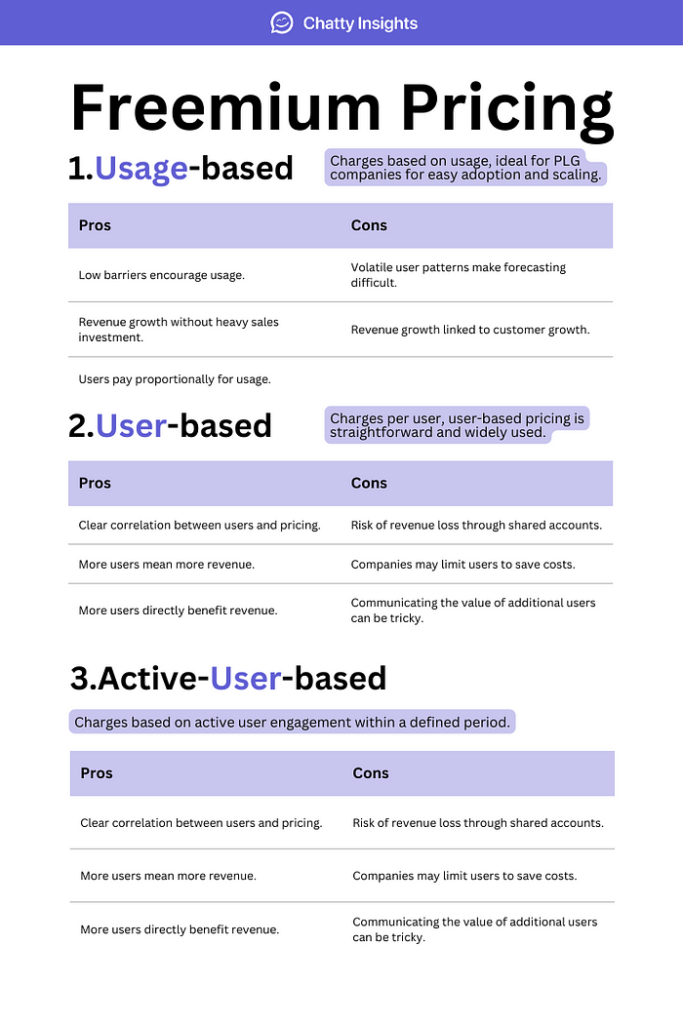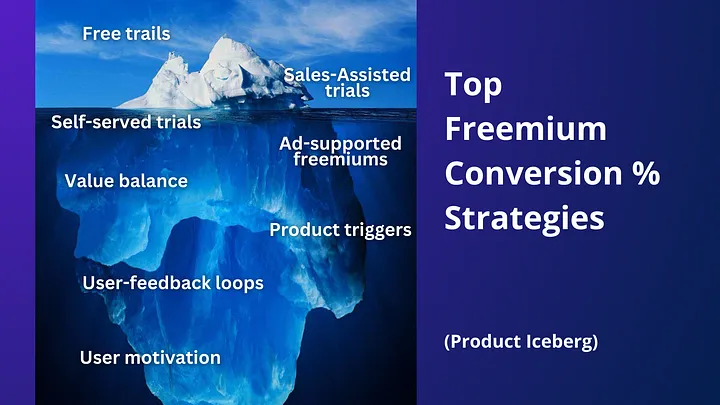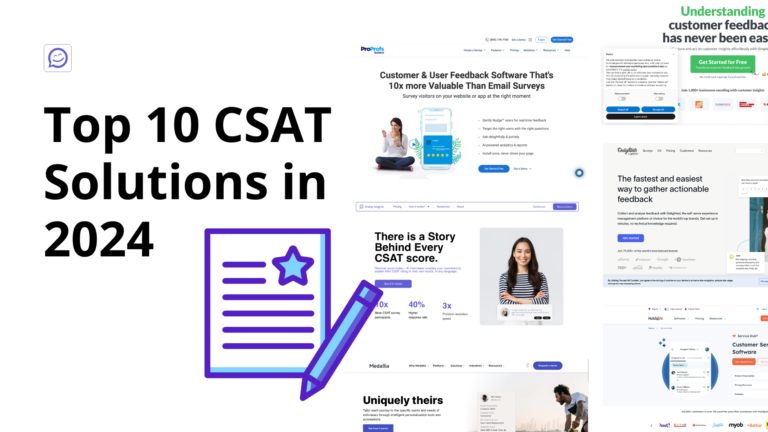The evolving landscape of the 2024 freemium model has experienced a 2.4% growth in major sectors, as reported by Mixpanel on the Product Benchmark. Below, we provide details on free-to-paid conversion strategies, pricing models, and motivation factors. Happy reading!
What is a freemium model?
Product-led businesses need to attract their target audience without restricting their reach. The freemium plan is an excellent tool for boosting lead generation. However, the freemium model is, of course, one of many options for generating revenue. Other options include free trials, reverse trials, and sales-assisted pilots.
Companies like Spotify, Dropbox, and MailChimp in the B2C and B2B space have defined the Freemium insights as a pillar of their go-to-market strategies.
Why is Freemium so important?
Let’s take a look at MailChimp’s product strategy, for example. In 2009, they launched a freemium version of their service with options to upgrade to paid plans for extra features and higher limits. The change was strategic to unlock the platform for small businesses, which had just started with email marketing.
Over the years, Mailchimp has continued to refine its freemium offering. It adapted to changes in the market and expanded its service offering beyond email marketing.
Meanwhile, companies like Mixpanel implemented freemium models just a short time ago. It has worked whether they did it to increase the website conversion rate or expand the user base. From 2020 to 2021, Mixpanel had a 200% increase in signup volume, according to Rollworks.

The core idea of the freemium model is to ensure that the free user is doing well. Mailchimp acquires customers early in their journey and educates them to upsell larger packages in the future.
Is it the only way to rule around the pricing strategy for SaaS?
According to the SaaS benchmarks from OpenView, product-influenced revenue is most significant with a self-serve freemium model — this type of revenue accounts for about 90% of their total revenue.
There needs to be more than just offering a freemium option. Revenue influenced by SaaS products can vary. It ranges from 28% in the lower quartile of companies to 100% in the upper quartile. We know the freemium model is effective, but how it is utilized is another question.
Freemium Conversion Rate
Across all existing trials, freemiums are the most challenging ones. Businesses need to find a source of continuous revenue, so having profit-generating levers to enable upselling is essential. Many SaaS businesses need help finding those levers, resulting in negative revenue statements.
In 2024, the typical Freemium conversion rate falls between 2–6%, while outstanding rates can climb as high as 8%. Freemium offerings and specific industry factors directly influence the ratio. Our advice is to focus at least on 3% and move forward.

The freemium-to-paid conversion rates in various SaaS industries exhibit significant variance. For instance, industries like Legal/LegalTech and RegTech show notably higher conversion rates. Because their services are essential and valuable, more users want to switch from free to paid versions.
Conversely, sectors such as education and edtech exhibit lower conversion rates, with factors like budget constraints, the non-essential nature of certain services, or less alignment between the product offerings and the users’ needs directly influencing freemium conversion rate optimization.
More stats according to OpenView Partners 2023 Product Benchmarks:
Freemium (self-serve) — exemplified by Dropbox and Slack
- Acceptable: 3–5%
- Excellent: 6–8%
Freemium (sales-assisted) — represented by Asana, Intuit, and Mailchimp
- Acceptable: 5–7%
- Excellent: 10–15%
Reverse trial — such as Notion and Zoom
- Acceptable: 7–11%
- Excellent: 14–21%
Free trial — like Microsoft and Adobe Creative Cloud
- Acceptable: 8–12%
- Excellent: 15–25%
Understanding Freemium Conversion
A free-to-paid journey is not the only safe option to make the product accessible. We leverage PLG investments to achieve steady growth and enhance efficiency by reducing human efforts.
One of the innovative metrics for evaluating PLG effectiveness is product-influenced revenue (PIR), which measures the amount of new revenue generated from customers who engage with the product before any sales interaction.
In the picture below, you can see the influence of freemium conversion on business revenue.

Pros and Cons of Freemium Models
PROS
- Lower Barriers to Entry. The allure of ‘free’ is understandable. A Freemium model lowers the entry barrier. It encourages a broader user base to experience your product without immediate commitment.
- Product Viral Loop. Users who appreciate the free version are more inclined to suggest it to others, enhancing your product’s exposure.
- Data-Driven Insights. The behavior of users with your free version enables your marketing using big data sets. Therefore, decisions should be made based on premium conversion analytics instead of assumptions.
Despite the appeal, there are a few freemium model conversion challenges:
CONS
- Resource-demanding. Supporting a large base of non-paying users can strain your resources, such as exceeding CRM capacity. With Hubspot, you can manage marketing contacts, unlike other CRMs that require payment for the total capacity.
- Conversion Dilemmas. Transitioning users from free to paid tiers is a nuanced process. It often demands specific strategies to achieve substantial conversion rates.
- User Retention. Freemium users may exhibit lower loyalty levels, heightening the churn risk.
Optimizing Freemium Conversion Rates
Practical strategies will boost conversion rates when converting freemium to the premium plan.
Here are some tactics to consider:
- Tailored Communication. Engage users with personalized messages highlighting premium features’ value, directly addressing their needs and usage patterns.
- Strategic Timing. Introduce premium features when users most likely recognize their value.
- User Experience Optimization. User feedback on the freemium model offers businesses a clear idea of what makes some users upgrade and others not. Here are a few feedback tools giving free-to-paid user upgrade Insights.
- Sales and Onboarding Process. Direct outreach can notably impact users, especially during their initial product experience, increasing their likelihood of converting.
Pro Tip: User onboarding is more than retaining users with current methods. It’s also about exploring new approaches within the existing process. For example, Semrush’s offboarding process emphasizes what customers will miss out on once their trial periods are over.

Guidelines for Non-Technical Founders
Navigating the freemium strategies can be particularly challenging for non-technical founders.
Maintaining a delicate balance of value between the free and premium tiers is essential. The free version should offer enough freemium value to engage users while making the advanced tier enticing. This ensures that users see the value in upgrading to a paid plan.
Additionally, users should clearly understand what they gain by moving to a premium tier. This clarity is enabled through transparent communication and easily accessible upgrade paths. Furthermore, continuous monitoring of user behavior and conversion patterns is crucial. Those adjustments ensure product alignment with evolving user expectations and market trends.
Short recap:
- Find value balance.
- Make clear the difference between upgrading tiers.
- Analyze user behavior to adapt to new challenges.
Freemium Pricing Strategies
Revenue optimization is always challenging, freemium business model impact on revenue. Even with 1 million active users, the business does not necessarily prosper. Finding why users would pay for an extra value is the biggest challenge.

Here is a cheat sheet to make it easier:
- Feature-Based Freemium. This model offers a free basic product version with limited features or functionality. Users can then upgrade to a premium version to access other features or unlock advanced capabilities. For example, Canva offers a free creative platform with limited template access.
- User-Limited Freemium. This model restricts the number of users or accounts accessing the product for free. Once the user reaches the limit, they must upgrade to a paid plan to add more users or accounts. Example:Slack provides a free version with user limits.
- Time-Limited Freemium. In this model, users have access to the full version of the product for a limited time, such as a free trial period. Example: Adobe Creative Cloud and Semrush offer a free 7-day trial for full software access. This type is also known as a reverse trial.
- Usage-Limited Freemium. This model imposes restrictions on the usage or access to the product. It may include a limited number of actions, storage space, or usage hours. For example, Mailchimp’s free plan has subscriber and email send limits.
- Ad-Supported Freemium. In this model, users can access the product for free but may encounter ads. For example, Spotify or YouTube’s free version includes ads between media.
Businesses must deeply understand their target market and usage patterns to find the optimal value proposition for upselling from a freemium model.
Customer feedback helps define freemium upgrade incentive strategies. Interviews offer valuable insights into how customers perceive the value of a product or service compared to its price. The feedback navigates businesses to determine the optimal price point for their offerings.
Chatty, an AI Customer Interviewer, simplifies gathering customer feedback. It assists businesses in researching monetization opportunities and identifying favorite features among users.
When asking for a free tier upgrade?
Every business can proactively identify upsell opportunities within its current free tier base. Companies can ask paid customers why they upgraded and what they value in the premium offering.
Using product-side triggers can improve the onboarding process, especially for SaaS companies. These triggers alert the customer support team when users reach usage thresholds or milestones.
This proactive approach spots upsell opportunities. It also allows businesses to personalize their messaging based on customers’ experiences, thus enhancing the effectiveness of upselling efforts.
Freemium Incentives and Motivations
These strategies target more than extra features; they also involve understanding and aligning with users’ motivations and needs. Coupled with freemium to premium upgrade motivators, they form a comprehensive approach.
Understanding why users upgrade from a free to a premium version may boost a company’s strategy. Here are a few of the ways:
- Feature Limits Reached. Users regularly hitting the limits of free features show they need more from the service.
- Engagement with Upgrade Info. Users who explore upgrade details or pricing pages are considering premium benefits.
- Community Engagement. Users actively participate in the community forums by asking questions or interacting with other premium users. These users are seeking information about advanced use cases.
- Utilization of Workarounds. If users are trying to find workarounds for features that are easily accessible in the premium version.
To determine if users are ready to upgrade their tier, closely monitor their engagement patterns and usage metrics. Users were hitting the limits of what the free version offers. Engaging frequently with content or premium features or actively seeking out advanced functionalities indicates readiness to upgrade.
Here are some of the ways to push those motivations forward:
- Special Offers
- Exclusive Features
- Personalization
- Priority Support
- Customer Success
- Feedback and Iteration
- Clear Communication of Benefits
Let’s simplify this with Duolingo’s example. They gamified language learning to keep users engaged and motivated to upgrade. Duolingo has a points system to track progress and social features so users can compare their progress with others.
The app offers activities, progress tracking, and friendly competition. This encourages users to engage more and leads them to upgrade to access additional features. If users enjoy the free version and see clear benefits in upgrading, they’re more likely to do so.
Businesses can utilize this knowledge by ensuring their free version is captivating and demonstrating evident worth in their premium product, similar to Duolingo’s approach.
Freemium wins the game
In 2024, the success of freemium models will depend on a deep understanding of user behaviors and preferences. Industry leaders like Mailchimp and Mixpanel illustrate the potential of well-timed, value-oriented upgrade prompts. These strategies are essential to effectively transitioning users from free to premium tiers.
AI can significantly enhance the process of gathering and analyzing user feedback, providing real-time insights and identifying patterns that might take time to be evident to quantitative analysts.
Tino, Founder of Chatty (Your AI User Insights on Autopilot)
Follow me on LinkedIn for more insights on using feedback with your users 🙂

